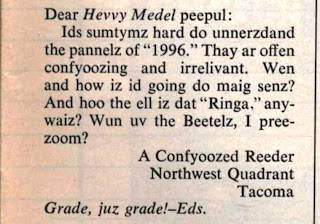Book Review: 'Burning Chrome' by William Gibson
4 / 5 Stars
‘Burning Chrome’ first appeared in 1986 as an Arbor House hardbound edition; this Ace paperback was released in October 1987 and features a cover illustration by Richard Berry.
These stories saw print in the interval 1977 – 1985 and are seminal entries in the genre of SF known as Cyberpunk (the term was coined in 1983 with the publication of an eponymous short story by Bruce Bethke in 'Amazing Science Fiction Stories').
At the time, in the early 80s, I was not really aware of what would come to be known as Cyberpunk. The truth was, genre SF at the time was pretty uninspired; the New Wave movement was long past its prime, and many of the ‘year’s best’ and other anthologies offered duds in terms of shorter fiction pieces. One bright spot for short stories was Omni magazine (where, in fact, 6 of the 10 stories in ‘Burning Chrome’ first appeared).
Novels of the early 80s could occasionally be worthwhile (e.g., ‘Footfall’ by Niven and Pournelle), but many were mediocre (e.g., ‘Dragon’s Egg’ by Robert Forward).
The advent of the ‘Ace Science Fiction Specials’ in 1984, and the publication of ‘Neuromancer’ as the marquee title, gave Cyberpunk and associated fiction a marketing profile that had not previously existed, and from then on it was easier to discover the genre.
My two cents on the contents of 'Burning Chrome' :
First up is ‘Johnny Mnemonic’ (Omni, 1981), the short story that inspired the film of the same name. ‘Johnny’ is as good an introduction to the genre as any Cyberpunk tale in the Canon. Reading ‘Johnny’ some 30 years after it first appeared, I’m struck by how readily this story’s approaches to style and content eclipse the majority of the material churned out by the New Wave scene over the period 1965 – 1981.
Next is ‘The Gernsback Continuum’ (Universe 11, 1981), in which a burnt-out, alienated photographer encounters ‘semiotic ghosts’ of a futuristic America that never was. This story, while devoid of the main trappings of Cyberpunk (such as neural interfaces with software / hardware, punk rock, and corporate machinations), nevertheless was a real influence on the development of retro-futurism in pop culture (a recent sculpture / art piece at the Burning Man Festival was titled ‘Raygun Gothic’).
‘Fragments of A Hologram Rose’ (Unearth, 1977) was the first Gibson story to see print, and it’s the weakest entry in the anthology, of value here mainly for the way it introduces some of the main tropes of the movement, such as interfacing with computers and experiencing virtual reality.
‘The Belonging Kind’, co-written with John Shirley, was released in the 1981 horror anthology Shadows 4. I’ve read this story multiple times, and it remains absorbing and creepy in its treatment of urban alienation and the existence of a race of mutants quietly patronizing the city night life.
It’s the perfect example of the kind of short story the New Wave authors would have given their right arm to write; highly original in theme and scope, but also written with a clear, well-managed style that inserts its metaphors and similes with care and forethought.
‘Hinterlands’ (Omni, 1981) deals with a psychiatrist who participates in ornate counseling sessions designed to debrief astronauts. On the surface this is a hard-sf tale that could conceivably have been created by a Larry Niven, or even an Arthur C. Clarke, but they would never have succeeded in imbuing their story with the unsettling undertone that Gibson weaves through ‘Hinterlands’.
‘Red Star, Winter Orbit’ (Omni, 1983): aboard a dilapidated Soviet space station, the crew contemplates mutiny.
‘New Rose Hotel’ (Omni, 1984): two black market data cowboys make a fateful decision to cross a corporate entity. A downbeat tale; in much of Gibson’s fiction, while the street-level strivers occasionally win one away from the multinational behemoths, the victory is often hollow.
‘The Winter Market’ (Stardate 1986): Virtual reality / entertainment engineer Casey befriends a crippled young woman named Lise.
In ‘Dogfight’ (co-written with Michael Swanwick, Omni, 1985), a gutter rat named Deke discovers an novel 3-D holographic video game. The story’s climactic contest is well-written and suspenseful.
‘Burning Chrome’ (Omni, 1982) is another quintessential Cyberpunk tale. Bobby Quine and Automatic Jack attempt to hack a corporate AI known as 'Chrome'. As with ‘The Belonging Kind’, the prose does everything the New Wave writers were trying to do, with an economy of effort rarely observed in those writers.










































































